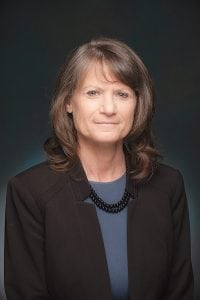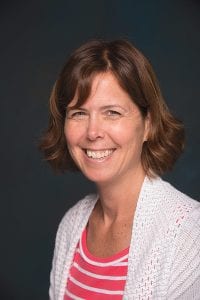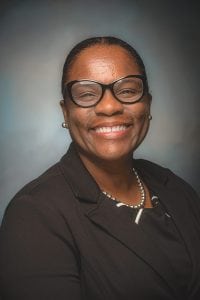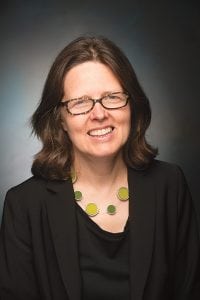The New College Try

Diane Prusank
Diane Prusank says Westfield State University is a few years behind the other Massachusetts state schools in adopting the so-called ‘college structure’ for its Division of Academic Affairs.
In most respects, that’s a good thing, she told BusinessWest, because it has provided the 180-year-old institution with an opportunity to learn from what those other schools have done and shape a system that reflects what amounts to best practices. And that’s important, because going from 25 academic departments to four colleges is a significant change for students and faculty alike.
“It takes time for people to see how this works, time for people to talk with those at other institutions and say, ‘how did this go for you?’” said Prusank, who last spring was named WSU’s provost and vice president for Academic Affairs. “So, in some ways, coming later than our sister institutions was really beneficial.”
Elaborating, she noted that the delay, if it can be called that, in adopting this structure resulted from, among other things, apprehension that it might create silos at the university at a time when greater collaboration between the departments was and is the goal, as well as an additional (and perhaps unwanted) layer of bureaucracy.
But over the course of a 15-month planning period — one that included examination of what’s happened at the other state universities and other institutions of higher learning after they adopted the college system — it was determined that these fears were mostly unfounded.
In fact, that review showed the college structure fostered greater communication among faculty members within various programs, and also new collaborative efforts.

Jennifer Hanselman

Juline Mills

Emily Todd
Once you place faculty essentially in proximity to each other in the kinds of meetings and events that colleges put together, they create a chemistry with each other that you don’t see when they’re spread out across 25 different departments,” said Prusank, who joined the university in 2008 as dean of Academic Programs and Accreditation.
“When there are eight of them in the room, they start to talk about things they have in common,” she went on. “And they start to create connections. Sometimes people worry that when you create the college system you’ve made silos, that these colleges will separate themselves from each other. But the truth is that those deans have conversations with other, and they make connections.”
Under the new system, WSU now has four colleges — the College of Graduate and Continuing Education, the College of Mathematics and Sciences; College of Education, Health, and Human Services; and College of Arts, Humanities, and Social Sciences.
Three new founding deans were also appointed in June: Jennifer Hanselman, former chair of the Department of Biology, was appointed interim dean of the College of Mathematics and Sciences; Juline Mills, most recently a professor in the College of Business at the University of New Haven, was named dean of the College of Education, Health, and Human Services; and Emily Todd, former chair of the Department of English at WSU, was named interim dean of the College of Arts, Humanities, and Social Sciences.
As for Prusank, she brings a great deal of experience to her new role as provost and vice president of Academic Affairs — and the process of bringing the college system to fruition.
Before coming to WSU a decade ago, she served as a faculty member, associate dean, and assistant provost at the University of Hartford. At Westfield State, in addition to her work as dean of Academic Programs and Accreditation, she’s served as dean of Undergraduate Studies, chair and faculty member in the Department of Communications, and chief of staff in the President’s Office.
Thus, she brings a number of different perspectives to the shift from 25 departments to four colleges. And from the lens of both a faculty member and administrator, she said it brings with it considerable promise for enhanced collaboration and innovation, as well as greater operational efficiencies.
“You get a lot of points of sharing that you didn’t have before,” she said, referring, again, to what happens when you bring the chairs of eight departments together for meetings of the individual colleges. “You get a lot of synergy, a lot of collaboration, and a lot of sharing. And that’s great for our students because it opens up more opportunities for them.”
Elaborating on the nature of these opportunities, she said they come in many different forms, from greater collaboration on curriculum and potential new programs of study to creation of new events, to the broadening of existing events, such as alumni gatherings, which might now involve graduates of several different (but related) programs instead of one.
“You get a lot of points of sharing that you didn’t have before. You get a lot of synergy, a lot of collaboration, and a lot of sharing. And that’s great for our students because it opens up more opportunities for them.”
“There’s synthesis and collaboration that opens doors for students that might not have been there before,” she explained.
Prusank told BusinessWest that a shift to the ‘college’ format is something that’s been under consideration at the university for some time.
“Westfield State has had this conversation periodically over the past few decades, as most institutions have,” she explained. “Eventually, the college structure found its way onto college campuses across the country.”
Discussions were ongoing when Ramon Torrecilha took the helm as president in 2015, she went on, adding that he essentially took the conversation to a higher level, asking the advisory committee on academic planning to research the college format, talk with campus constituencies, look at what other schools had done, and make a recommendation on what should be done moving forward.
The eventual recommendation was to take this step, she said, adding that what followed was a lengthy implementation period involving work to determine, among other things, how many colleges would be created and the composition of each one (the specific departments). When that work was completed, searches were conducted for the deans that would lead each college, as well as for the provost and vice president of Academic Affairs.
While there will be a period of adjustment to the new system, Prusank said the many types of benefits are becoming increasingly apparent to students and faculty alike. Chief among these benefits for students is greater access to assistance when its needed.
“With the older structure, when we had a dean of Undergraduate Studies, students who had academic issues or problems would have to go to that dean, and there are 4,500 full-time undergraduate students looking for one person,” she explained. “Now, with the four-college structure, there are four different points of access; it’s easier to get that individual quicker.”
There are many other benefits to this system, she told BusinessWest, adding that, while WSU may be the last school in the state system to embrace this structure, it is already making up for lost time.
— George O’Brien





